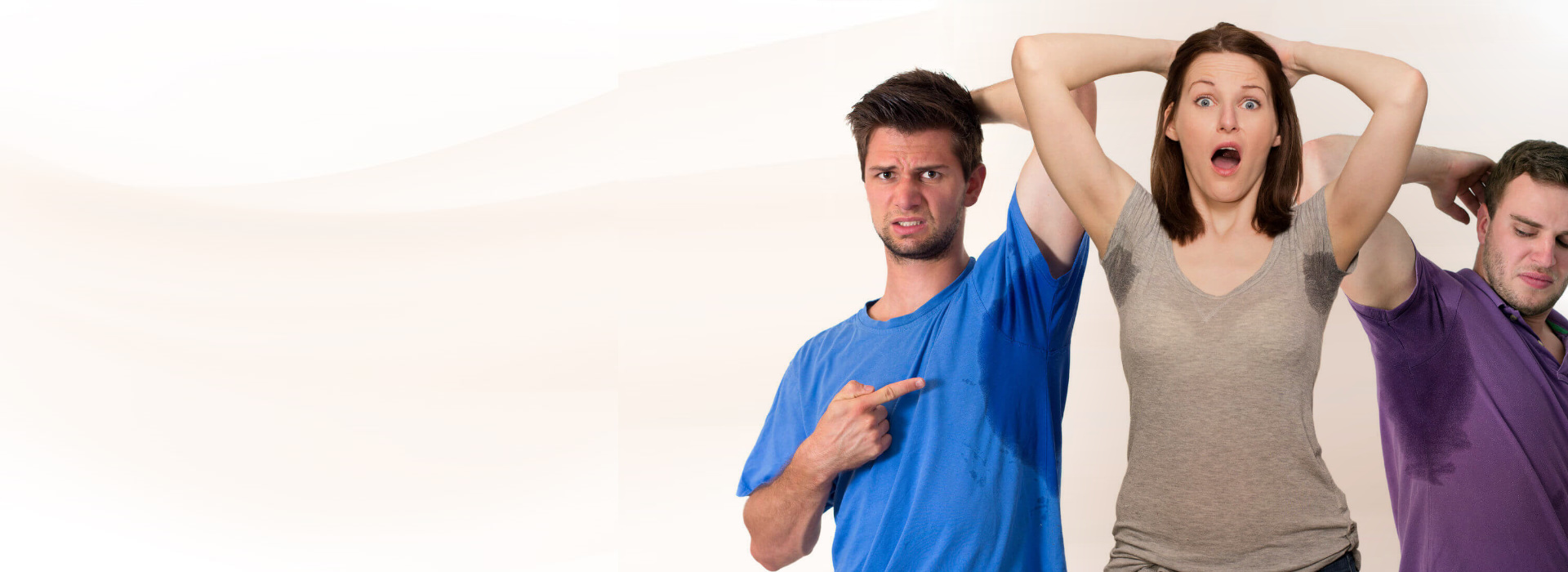the American Society of Plastic Surgeons (ASPS) and The Aesthetic Society (ASAPS).
OVER 6400 Five Star Reviews!

Get Rid of
Excessive Sweating
Experience the benefits of an FDA-APPROVED solution for hyperhidrosis.
Appointment
Most Effective
Anti-sweating Treatments
Get started on your journey to sweat-free living
Appointment
CHICAGO HYPERHIDROSIS (EXCESSIVE SWEATING)
I. Definition:
Hyperhidrosis is the medical term for excessive sweating. It is a troublesome condition that results in uncomfortable and awkward social situations for those who are affected by it. The problem may be limited to the armpits, but often the palms and soles sweat excessively also. Excessive sweating becomes noticeable after puberty. Stressful situations such as examinations, job interviews, or an important date will aggravate the sweating. Many affected individuals must change their shirts or socks several times a day, or constantly wipe their hands self consciously. Most over-the-counter antiperspirants do not control Hyperhidrosis.
If you suffer from excessive sweating, you are not alone. It is estimated that several million people in the world are affected by Hyperhidrosis - approximately 1% of the world population!
II. Excessive Sweating Causes
There are many triggers (anxiety, stress) but the exact cause is really unknown.
III. Treatment
(a) Brella
Brella with recent FDA-clearance. The Brella SweatControl Patch is an in-office 3-minute treatment that uses a patented “targeted alkali thermolysis” (TAT) technology to reduce excessive underarm sweating. The sodium sheet targets sweat glands to slow sweat production and stop excessive sweating. This new, three-minute option promises three to four months of relief.
This treatment uses a patented technology to block the signals that trigger sweat production, effectively reducing the amount of sweat your body produces. What's more, Candesant Biomedical is safe and non invasive, with no downtime required. So if you're looking for a solution to excessive sweating that actually works, Candesant Biomedical may be the answer for you.
(b) Botox for Excessive Sweating
Botox is the trade name of Botulinum Toxin Type A. This toxin blocks nerve impulses when injected into the muscles that cause frown lines. Once the muscle(s) can no longer contract, the action of frowning is stopped, and frown lines diminish. Now you can soften and reduce frown lines without surgery and without scars. However, experimental studies have recently revealed that it helps patients with hyperhidrosis. It typically reduces the amount of sweating by 70-90%!
How is the procedure done?
Botox is currently used in our office to decrease excessive sweating in the underarms (axillae), palms (hands), and soles (feet). Prior to the injections, a topical anesthetic ( ELA-Max)
is placed on the skin. The cream is left in place for 20 - 30 minutes to numb the skin prior to the injections. The topical anesthetic is usually the only pain control necessary for the injections in the under arm. If the palms
and soles are to be injected, the physician may choose to perform a nerve block that numbs the entire hand or foot. These nerve blocks consist of 3-4 injections per hand or foot using a small needle. After the injection, the treated
hand or foot will feel numb for 30 minutes to one hour. You are advised not to drive for 2 hours after having these anesthetic injections because they may interfere with your ability to drive
After the area to be treated has been numbed with topical cream or the injections, Botox injections are performed in the area to be treated. The needle that is used is a 30 gauge needle which is the same size as an acupuncture needle. Approximately 40 injections will be performed in each hand or foot or 20 injections per underarm.
After the injections, the skin may appear slightly bruised, and the skin will feel numb from the anesthesia. After 2 hours, normal activities can be resumed including exercise.
The most common side effect of this procedure is bruising and mild soreness in the treated areas. Because this treatment is also used to relax muscles, it is possible to develop decreased muscle strength in the treated areas. This is most often noticeable in the hands and is most bothersome to tennis players, piano players, and others who rely on good muscle strength in the hands. Although this side effect is not common, it does occur and may last for a few months in some individuals. Other side effects associated with the same dose of Botox in the clinical trials examining its use in cervical dystonia include dry mouth, muscle soreness, and dyspepsia (indigestion). These side effects are all temporary.
When does Botox start to work & how long does it last?
The results of a Botox treatment start to appear in 3 to 10 days. The treated area will start to gradually regain its sweating propensity over 3 to 9 months. When sweating
starts to reappear, a simple repeat treatment is all that is necessary to maintain the desired result.
**Botox, when used by an experienced physician, is a safe and effective way to eliminate the embarrassing problem of excessive
sweating of the underarms, hands and feet.
Another line of excessive sweating treatment is medical-grade deodorants. Unfortunately, these usually do not help much. Many other things have been tried - topical medications, oral medications, iontophoresis, and surgery - but they have not proven to be very effective in the majority of patients. Until recently, there was really no other solution.
(c) MiraDry
Miradry is a revolutionary non-invasive treatment for hyperhidrosis. It uses microwave technology to target and eliminate sweat glands in the underarm area, providing long-lasting results. The procedure is safe and effective, with little side effects. During the treatment, a handheld device is used to deliver controlled microwave energy to the sweat glands, destroying them without damaging the surrounding tissue. The treatment takes approximately one hour and can significantly reduce underarm sweating, odor, and hair growth. Miradry may be an excellent option for those who suffer from excessive sweating and wish to improve their quality of life by reducing the embarrassment and discomfort associated with this condition.
23 Things To Do While Recovering From Your Surgery

